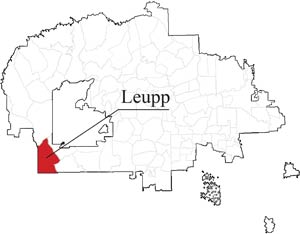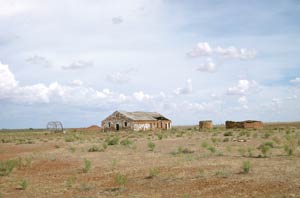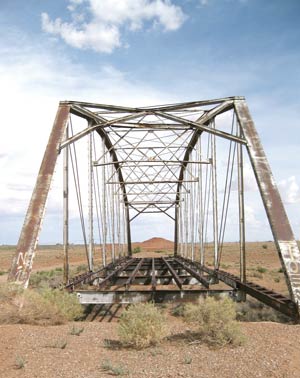The birthplace of chapters
Leupp has a history of both progress and paranoia
By Cindy Yurth
Tséyi' Bureau
LEUPP, Ariz., July 18, 2013
(Editor's note: In an effort to chronicle the beauty and diversity of the Navajo Nation, as well as its issues, the Navajo Times has committed to visiting all 110 chapters in alphabetical order. This is the 44th in the series.)



L eupp native Paul Thompson has an easy test for whether someone is an outsider. He merely waits until they pronounce the name of his chapter.
"If they say 'Lee-up,' he said, 'they're not from around here. The 'e' is silent."
However, Thompson, 66 ("like the Route"), cannot tell you who his chapter is named after.
"Some white guy," he says, frowning. "Probably a trader."
In fact, Francis E. Leupp was one of the best friends the Navajos ever had, at a time when they sorely needed friends. A former muckraking journalist, he was appointed Indian Commissioner by President Theodore Roosevelt in 1905.
Leupp was already a member of the Indian Rights Association, and had written several articles about the appalling conditions in the off-reservation boarding schools, which he called "educational almshouses."
Upon his appointment, it didn't take Leupp's reporter's eye long to catch the inefficiencies in the Indian Bureau, and he prepared a plan for its gradual dissolution, much to the alarm of its many employees.
It was through Leupp's efforts the first of the "Aneth Extensions" was added to the tribe's northern border, and after Arizona and New Mexico became states and started clamoring for the "excess" lands of the Navajo, he quickly pushed through an allotment program to help Diné families hang onto their land in case the states made a grab (which they eventually did).
Unfortunately, Leupp was way ahead of his time. His policies were roundly attacked by the non-Natives and he was replaced the minute Roosevelt's term expired.
But Leupp Agency was named after him, and it was fitting that in 1927, John Hunt, the superintendent of that agency, created the chapter system to give Navajo communities more autonomy over their local affairs.
A shameful era
Unfortunately, through no fault of its own, Leupp was also the site of one of the more shameful chapters in American history: the internment of Japanese-Americans from the West Coast.
There were several internment camps during World War II, but Leupp's — located in its old boarding school that had been damaged by a flood — was one of those known as "isolation camps" or "penal camps."
These were for Japanese the government had branded as "troublemakers," sometimes just for protesting their treatment or wondering aloud why the Army was rounding up Japanese-Americans while Italian- and German-Americans, who arguably were equally likely to be Axis spies, were walking around free.
According to a 2008 presentation by Sara Begay, a 7th-grade teacher in Chilchinbeto who had had her students research the camp, it wasn't much of a prison.
The director was openly sympathetic to his charges and let them fix up an old truck to drive to Flagstaff for provisions. Although the camp was heavily guarded, the fence around it was only five feet high.
Fortunately, the camp was only open for eight months, but it was long enough for the Japanese to lose their livelihoods. Some highly educated Japanese, their bank accounts frozen and their property confiscated, ended up moving to Phoenix and becoming gardeners.
Leupp was also the site of one of the first Indian boarding schools, and education continues to be important to Leuppites today. The children have their choice of a BIE, public or charter elementary school (the Star School, just outside the chapter boundary), and when it's time for high school, they can stay at the BIE school or be bused to Flagstaff, which is only about 45 miles away.
There's also a clinic, various government offices and a convenience store, plus a thriving flea market on the weekends.
'The Crack'
Leupp has one quasi-tourist attraction: the eerie geologic feature known simply and "The Crack."
This crevice in the earth is between two and four feet wide, about a football field long, and so deep that, in places, you can't see the bottom.
"It's weird," said Alyssa Granger, 15.
"It's getting bigger, too," added her cousin-brother, Ryan Begay, also 15.
George Billingsley, a retired research geologist with the United States Geologic Survey who mapped most of the area during his career, said The Crack is not unique.
"There's probably 30 or so between Winslow and the Grand Canyon," he said, "all running in a northwesterly direction."
Billingsley said the cracks are a result of the Earth's crust in this area being gradually pulled apart, as though two people had grabbed opposite ends of a table and each pulled in their own direction.
The cracks are very deep — a spelunker who explored one near Wupatki rappelled down 500 feet before it got so narrow he couldn't go any farther.
"These things can be extremely narrow at the bottom," Billingsley said, "so it's possible he was only halfway down."
Even spookier, the cracks "breathe."
"They can blow or suck air, depending on the atmospheric pressure," Billingsley said, adding that he's felt what was probably a 45-mile-per-hour wind coming out of one of the cracks.
"It was enough to take my hat off," he recalled.
When the surrounding air pressure is high, the air rushes into the crack, the geologist explained. When it lightens up, the compressed air in the crack rushes out like an exhalation.
As to whether or not the crack is expanding, Billingsley said it surely is, but he doubts it's enough to be noticed.
"Maybe one inch in 15 years," he hypothesized.
Gradual change
That's how change is in these parts, too. While you're watching, you might not notice it, but Leupp has made significant progress over the decades: the paving of N-15, the schools, and the chapter form of government that was adopted throughout the reservation.
Maybe Twin Arrows, the tribe's new flagship casino on I-40, will change the economic landscape too? Thompson says it hasn't yet.
"We were expecting a lot of jobs from it," he said, "but it didn't really happen. Maybe they couldn't find anybody here who didn't have a (criminal) record."
Thompson has his way of identifying outsiders, and maybe a dry sense of humor is a way of identifying Leuppites.
It certainly applies to Alfred Tsosie, who drives the bus for the seniors.
Tsosie raves about the chapter manager.
"She's really nice," he says. "Such a good person. I enjoy working for her."
Becoming suspicious, the reporter notices the chapter manager and the bus driver have the same last name.
Tsosie finally admits Clara Tsosie is his wife.
Leupp at a glance
Name — after Francis E. Leupp, Indian commissioner under President Theodore RooseveltPopulation — 951 at the 2010 Census
History — Leupp grew up around the Little Colorado River, where early residents planted corn, beans and squash on the flood plain. After a series of floods in the 1940s, the town was moved to higher ground at its present location on N-15. Leupp has the unfortunate distinction of being one of the places where the U.S. Army interned Japanese-Americans during World War II. Leupp was also the very first Navajo chapter, and comprises the southwestern corner of the Navajo Nation.
Attractions — Grand Falls, "The Crack," near to Twin Arrows casino
Land area — 303,746 acres
Industries — El Paso Natural Gas and the Transwestern Pipeline have facilities here, and Tooh Diné Industries manufactures circuit boards

